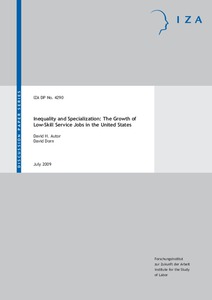Inequality and specialization: the growth of low-skill service jobs in the United States
"After a decade in which wages and employment fell precipitously in low-skill occupations and expanded in high-skill occupations, the shape of U.S. earnings and job growth sharply polarized in the 1990s. Employment shares and relative earnings rose in both low and high-skill jobs, leading to a...
| Main Authors: | , |
|---|---|
| Institution: | ETUI-European Trade Union Institute |
| Format: | TEXT |
| Language: | English |
| Published: |
Bonn
2009
IZA |
| Subjects: | |
| Online Access: | https://www.labourline.org/KENTIKA-19187348124919055209-inequality-and-specialization-.htm |
| Summary: | "After a decade in which wages and employment fell precipitously in low-skill occupations and expanded in high-skill occupations, the shape of U.S. earnings and job growth sharply polarized in the 1990s. Employment shares and relative earnings rose in both low and high-skill jobs, leading to a distinct U-shaped relationship between skill levels and employment and wage growth. This paper analyzes the sources of the changing shape of the lower-tail of the U.S. wage and employment distributions. A first contribution is to document a hitherto unknown fact: the twisting of the lower tail is substantially accounted for by a single proximate cause - rising employment and wages in low-education, in-person service occupations. We study the determinants of this rise at the level of local labor markets over the period of 1950 through 2005. Our approach is rooted in a model of changing task specialization in which "routine" clerical and production tasks are displaced by automation. We find that in labor markets that were initially specialized in routine-intensive occupations, employment and wages polarized after 1980, with growing employment and earnings in both high-skill occupations and low-skill service jobs." |
|---|---|
| Physical Description: | 38 p. Digital |

